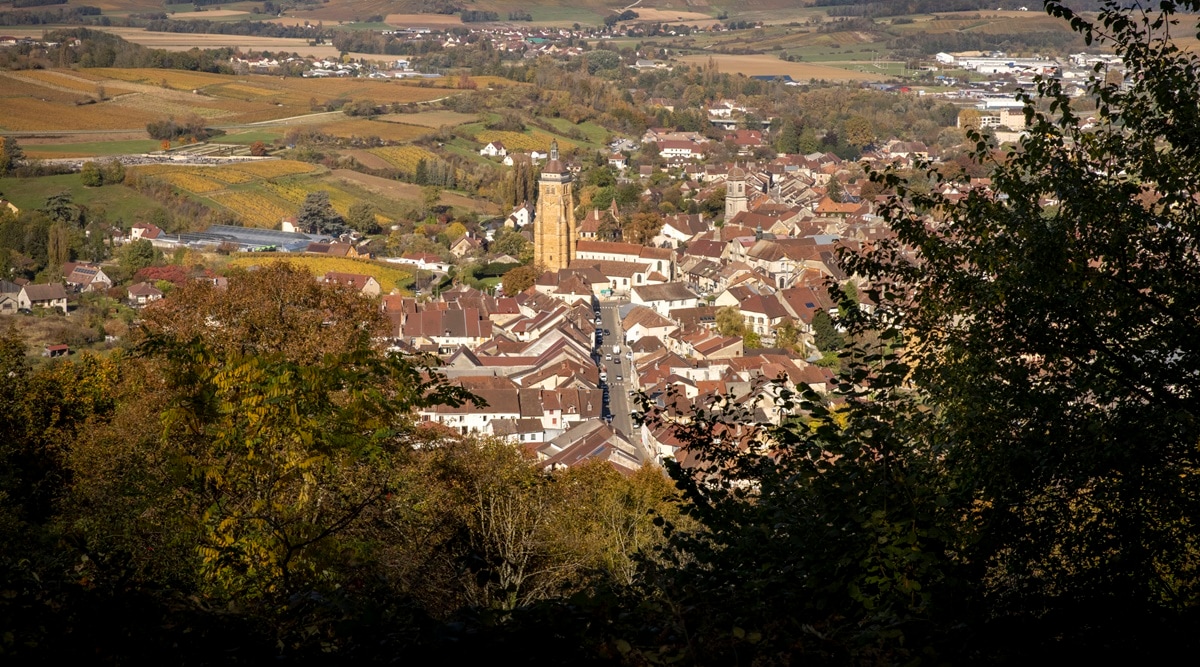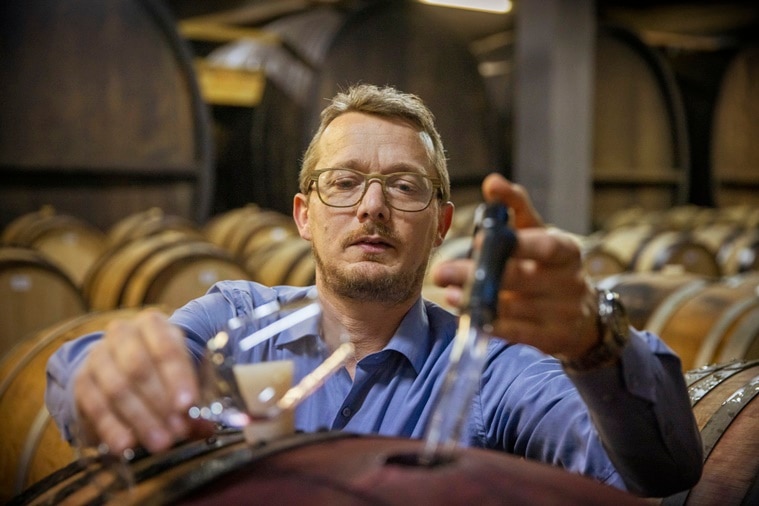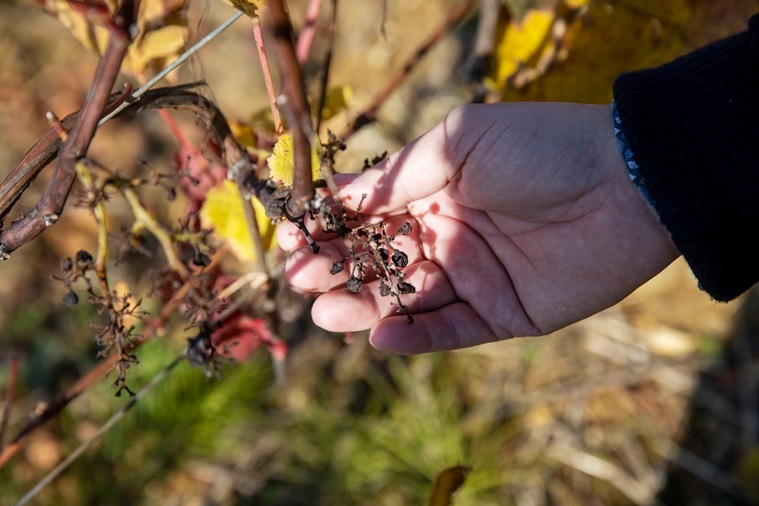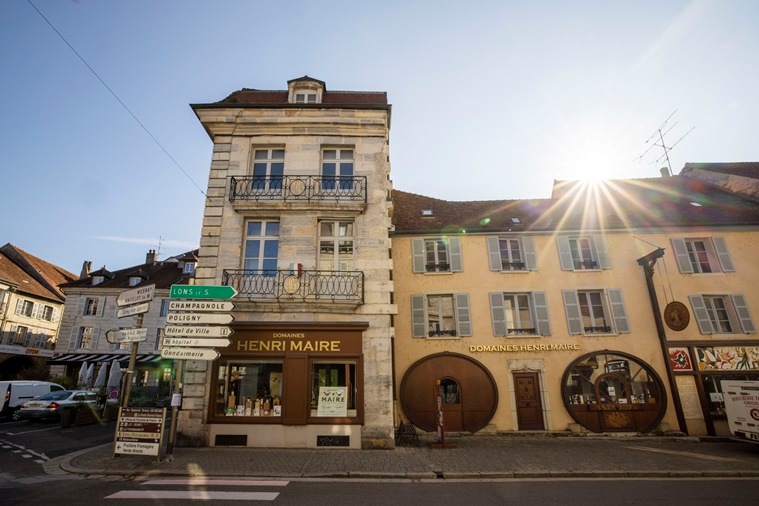 Arbois commune, in the small winemaking Jura region of France. (Reto Albertalli/The New York Times)
Arbois commune, in the small winemaking Jura region of France. (Reto Albertalli/The New York Times) Written by Ceylan Yeginsu
On the banks of the Cuisance River in eastern France, scattered between the ancient stone houses of the Arbois commune, small groups of wine enthusiasts sat under the fall sun, sipping on chardonnay and trousseau grown in the foothills of the Jura mountains, one of the smallest but most beloved wine regions in France.
For many of the American tourists visiting the area on a recent October afternoon, it was their first excursion to Europe since the coronavirus pandemic closed borders last year. Huddled over guidebooks and maps, they marked prospective destinations for their next tasting with palpable excitement. But in the nearby vineyards, where the annual grape harvest was recently completed, a somber mood prevailed.
As government and business leaders meet in Scotland for a consequential United Nations climate conference, considering global measures to combat climate change, winegrowers in Jura are enduring its impact on their livelihoods now. They have been grappling with record crop losses caused by frost, hail and higher temperatures, all spurred by climate change. These extreme weather conditions, which have compounded over the past five years, have led to despair and suicides in the region, as locals worry about how they will maintain the unique properties of their wines when their grape harvests persistently fail.
 Jacques Hauller, facility manager for Domaine Maire and Fils, which managed to produce a steady stream of wine over recent years, but this year lost at least 40 percent of its crop and endured mildew and disease, in the Arbois commune, France. (Reto Albertalli/The New York Times)
Jacques Hauller, facility manager for Domaine Maire and Fils, which managed to produce a steady stream of wine over recent years, but this year lost at least 40 percent of its crop and endured mildew and disease, in the Arbois commune, France. (Reto Albertalli/The New York Times) “We lost 85% of our crop compared to last year,” said Fabrice Dodane, 49, the owner of Domaine de Saint-Pierre, a small wine producer that specializes in organic viticulture. “It is truly a disaster, and people are angry because there is so much demand but not enough wine to sell.”
Despite being one of France’s smallest wine regions, spanning just over 50 miles and representing only 0.2% of the country’s wine production, Jura has an economy heavily reliant on winemaking, and its vintages in the past 15 years have increasingly drawn international acclaim. The area’s diverse soil and grape varieties have produced boundless shades and styles, but its organic, natural and sparkling wines have grown particularly popular in New York, Tokyo, Copenhagen and London.
Jura’s semi-continental climate, traditionally defined by cold winters and dry, warm summers, has created the wines’ distinctive properties. But since 2015, weather has become increasingly unpredictable. One of the most dramatic changes has been the warmer winter temperatures, causing vine buds to break — or open — early, leaving them exposed to frost, which can destroy the vines in one night. “When the winters were cold, the vines would sleep through the frost, but now with the warmer winters, they wake too early and become vulnerable,” said Gabriel Dietrich, director of Fruitiere Vinicole Arbois, the largest cooperative, of 100 wineries, in the Jura region.
But in 2021, Jura experienced devastating weather conditions almost relentlessly.
“This year we had terrible frost in April, then hail in June, followed by a horrible cold summer with lots of rain that caused disease in the vineyards and rotted the grapes,” Dietrich said.
 Grapes ruined by frost in the Arbois commune, France. (Reto Albertalli/The New York Times)
Grapes ruined by frost in the Arbois commune, France. (Reto Albertalli/The New York Times) The Fruitiere Vinicole Arbois has seen a steady decline in output since 2017. While the cooperative typically produces around 475,000 gallons, or 18,000 hectoliters, of wine after a normal harvest, in 2017 its yield fell more than half, to 185,000 gallons. It has continued to drop, with 2021 bringing in only 119,000 gallons.
“We are living a true crisis in the Jura; we’ve never seen anything like this,” Dietrich said. “Some winegrowers weren’t even able to harvest this year, because they had nothing.”
The last year the region had favorable weather conditions was 2018, which wine experts say produced some exceptional wines. Yet with high demand and a limited crop, prices have increased, and certain labels, like the 2018 Pierre Overnoy Arbois-Pupillin Poulsard, are hard to find. This has put tremendous pressure on winegrowers to sustain production, and many are struggling to stay afloat.
Four revered French winemakers ended their lives this year. One of them, Pascal Clairet of Domaine de la Tournelle, was an iconic figure of organic viticulture in Arbois, producing some of the edgiest award-winning natural wines in the past 20 years. His death shocked the region.
“The Jura is an extreme example because it is this tiny region that offers a breadth of range and particularity, and the second a certain cuvée gets good press coverage, there is suddenly this huge interest and not enough to go around, which puts an immense burden on the winegrowers,” said Wink Lorch, author of “Jura Wine” and a wine expert who has been studying the region for more than 20 years.
“In the early 2000s there was a real effort by Jura winemakers to attract export sales and, related to this, the wine-aficionado tourists from overseas,” she said. “Now that has almost backfired, with all the weather problems and the success of their wines.”
High Cost, Low Yields and Bureaucracy: The Obstacles to Experimentation
The impact of climate change, however, has not been entirely detrimental for winemaking, particularly for red grape varieties like pinot noir, which benefit from hotter summers. When a bud breaks early and is exposed to heat from the sun, the ripening of the grape accelerates, giving it a nice color and a good amount of tannins, said Jacques Hauller, facility manager of Domaine Maire & Fils, one of the largest wine estates in the Jura area.
“In this way, the challenge of global heating helped us a lot because we were able to make some pinot noir that won awards in the U.K. and France,” he said. “Usually this region is not known for high-level pinot noir.”
Domaine Maire & Fils spans more than 490 acres and has managed to consistently produce a steady stream of wine from the Jura region, even this year, after losing around 40%-50% of its crop compared to 2020. In one room of the company’s winery, around 300,000 bottles of wine were stacked high, maturing for three to 20 months before being shipped to global markets.
“This year we had lots of problems with our organic production because there was a lot of mildew and disease,” Hauller explained, pointing at rows of chardonnay vines on one of the low-lying flat plains of the estate. “Of course, it’s much harder for individual or smaller producers who have a few parcels. Some of them lost everything.”
Vignerons like Dodane have been experimenting with techniques to shield their crops from winter frosts, like burning candles and using bales of straw and warm wind machines, but many complain that the costs are too high and the results limited.
 Downtown in the Arbois commune, France. Extreme weather has ruined grape crops throughout the small Jura winemaking region, known for natural wine. (Reto Albertalli/The New York Times)
Downtown in the Arbois commune, France. Extreme weather has ruined grape crops throughout the small Jura winemaking region, known for natural wine. (Reto Albertalli/The New York Times) Some winemakers are eager to experiment with different grape varieties that are more resilient to the changing weather patterns, but France is extremely strict about the grape varieties it allows to be grown in wine regions. The country’s regulatory body, Appellation d’Origine Contrôlée, has tweaked rules in recent years to allow for research and development of new varieties for climate adaptation, but the process is arduous and slow, and it could take years before new variations are approved, winemakers say.
“It’s quite complicated and will take time,” Hauller said. “I share the opinion with many other winemakers that the impact of global heating is faster than our process.”
This article originally appeared in The New York Times.
📣 For more lifestyle news, follow us on Instagram | Twitter | Facebook and don’t miss out on the latest updates!
- The Indian Express website has been rated GREEN for its credibility and trustworthiness by Newsguard, a global service that rates news sources for their journalistic standards.

